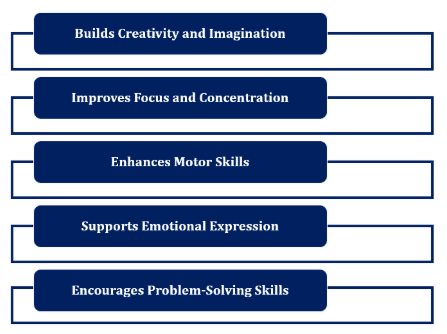
How Visual Arts Support Academic Growth in Young Learners
Fri Oct 31 2025
When we think of learning in schools, we typically imagine classrooms, books and exams. But, children learn in different ways. A single of the effective and enjoyable ways to learn is through visual art. Drawing, painting, sculpting, coloring, and even designing all play an important role in helping children to understand the world around them. Visual arts for children are not just for fun; they also build skills that aid in academic development.
Teachers and parents are often surprised that children who are involved in arts and crafts are more creative and observe things with greater attention and are more interested in studying. This is because of the fact that art allows children to explore their thoughts to ask questions, and think without limitations.
How Visual Arts Help in Academic Learning

Builds Creativity and Imagination
Creativity is among the most important strengths that children can develop. When children are exposed to visual arts for kids they learn to think beyond what they see. For example, a kid might draw a blue tree or even a flying car not because they're wrong, but simply because they're thinking of possibilities. The ability to think helps children write stories, solve puzzles as well as understand science concepts.
Improves Focus and Concentration
If children are seated coloring, painting, or even making art, they practice being in a specific place and focusing on a single task. When they do this regularly, it helps develop patience and focus. These skills are helpful when they have to read or solve math problems or prepare for exams.
Enhances Motor Skills
Activities like holding crayons, cutting paper, shaping clay, or folding paper help build fine motor skills. These activities strengthen the small muscles of the hands & fingers. Improved motor skills help improve handwriting, drawing and overall coordination.
Supports Emotional Expression
Children often struggle to explain what they feel. Art can be their language. When kids create art, they express joy and wonder, awe and even anxiety. This emotional release can help to keep their minds fit and more assured in the way they communicate.
Encourages Problem-Solving Skills
Art often comes with challenges - What color should I choose? How do I stick this shape? How do I make this look balanced? These little decisions help build thinking abilities. As time passes, children are taught to experiment, try to do it again if something fails and are happy when they come up with something completely new. This is an essential part of academic performance.
Benefits of Art and Craft in Daily Learning
The Benefits of art and craft go beyond making pretty projects:
- Students learn to look at the details with greater attention.
- They are better at recognizing shapes as well as colors and patterns.
- They are taught how to plan, what to do first and what to do next.
- Art reduces stress and makes learning more enjoyable.
- It helps to teach collaboration and sharing when done in groups.
Because of these reasons, schools are now incorporating art and craft sessions in their everyday learning, and not just as a hobby.
Ramagya Arts Academy – The Arts Academy in Noida
Ramagya Arts Academy is known as a thoughtful and inspiring arts academy in Noida where creativity is nurtured with great care. The academy focuses on helping children find their own unique voice in art rather than copying. They are encouraged by the teachers to ask questions, explore new techniques, and communicate their thoughts freely. The space is welcoming, warm and full of imagination.
No matter if a child wishes to master sketching, painting, making crafts, or even digital art, the academy provides the space to let them learn at their own speed. Their approach is kind and meaningful, and they celebrate the uniqueness of every child that is what makes the academy stand out as a dedicated arts academy in Noida.
How Parents Can Support Visual Arts at Home
- Give basic art supplies such as papers, colors, glue and scissors.
- Let children experiment and make mistakes.
- Make sure to display their art at home so that they feel appreciated.
- Enjoy creating art together as a fun family activity.
- Ask them questions regarding their artwork to encourage thought and expression.
These little steps can help children learn to be confident in their learning.
Conclusion
Visual arts go beyond painting or drawing. They are a meaningful way to help in learning, improving emotional wellbeing and build confidence. Through regular exposure to the visual arts for kids, and the benefits of art and craft, children become engaged, curious, expressive and enthusiastic learners. Art opens the way to imagination, and imagination opens the door to learning.
FAQs
Q1. At what age should children start art and craft?
Children can start around 2-3 years of age with simple scribbling and coloring. Their skills will grow naturally with time.
Q2. Do children need costly art materials?
No. Things like paper, crayons, old boxes, leaves, buttons, and newspapers are enough to spark creativity.
Q3. Can art help shy children?
Yes. Art allows shy children to express themselves quietly and slowly builds their confidence.
Q4. For how much time should children do art and craft?
Even 30-40 minutes a day, or a few times a week, can have great benefits.

